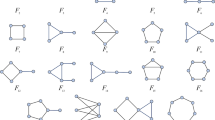Abstract
This paper concerns the facial geometry of the set of \(n \times n\) correlation matrices. The main result states that almost every set of r vertices generates a simplicial face, provided that \(r \le \sqrt{\mathrm {c} n}\), where \(\mathrm {c}\) is an absolute constant. This bound is qualitatively sharp because the set of correlation matrices has no simplicial face generated by more than \(\sqrt{2n}\) vertices.


Similar content being viewed by others
Notes
In our parameter regime, it is unlikely that any vertex of \(\mathscr {E}_n\) is chosen more than once, so this model is not substantially different from drawing vertices without replacement.
References
Ahlswede, R., Winter, A.: Strong converse for identification via quantum channels. IEEE Trans. Inform. Theory 48(3), 569–579 (2002)
Ben-Tal, A., Nemirovski, A.: Lectures on Modern Convex Optimization: Analysis, Algorithms, and Engineering Applications. MPS/SIAM Series on Optimization. SIAM, Philadelphia, PA (2001)
Bhatia, R.: Matrix Analysis. Graduate Texts in Mathematics, vol. 169. Springer, New York (1997)
Delorme, C., Poljak, S.: The performance of an eigenvalue bound on the max-cut problem in some classes of graphs. Discrete Math. 111(1–3), 145–156 (1993)
Goemans, M.X., Williamson, D.P.: Improved approximation algorithms for maximum cut and satisfiability problems using semidefinite programming. J. Assoc. Comput. Mach. 42(6), 1115–1145 (1995)
Grothendieck, A.: Résumé de la théorie métrique des produits tensoriels topologiques. Bol. Soc. Mat. São Paulo 8, 1–79 (1953)
Hiriart-Urruty, J.-B., Lemaréchal, C.: Fundamentals of Convex Analysis. Grundlehren Text Editions. Springer, Berlin (2001)
Karp, R.M.: Reducibility among combinatorial problems. In: Miller, R.E., Thatcher, J.W., Bohlinger, J.D. (eds.) Complexity of Computer Computations, pp. 85–103. Plenum, New York (1972)
Khot, S., Naor, A.: Grothendieck-type inequalities in combinatorial optimization. Commun. Pure Appl. Math. 65(7), 992–1035 (2012)
Koltchinskii, V., Mendelson, S.: Bounding the smallest singular value of a random matrix without concentration. Int. Math. Res. Not. IMRN 2015(23), 12991–13008 (2015)
Laurent, M., Poljak, S.: On a positive semidefinite relaxation of the cut polytope. Linear Algebra Appl. 223(224), 439–461 (1995)
Laurent, M., Poljak, S.: On the facial structure of the set of correlation matrices. SIAM J. Matrix Anal. Appl. 17(3), 530–547 (1996)
McCoy, M., Tropp, J.A.: Two proposals for robust PCA using semidefinite programming. Electron. J. Stat. 5, 1123–1160 (2011)
Nesterov, Yu.: Semidefinite relaxation and nonconvex quadratic optimization. Optim. Methods Softw. 9(1–3), 141–160 (1998)
O’Donnell, R.: Analysis of Boolean Functions. Cambridge University Press, New York (2014)
Oliveira, R.I.: The lower tail of random quadratic forms with applications to ordinary least squares. Probab. Theory Relat. Fields 166(3–4), 1175–1194 (2016)
Pisier, G.: Grothendieck’s theorem, past and present. Bull. Am. Math. Soc. 49(2), 237–323 (2012)
Poljak, S., Rendl, F.: Solving the max-cut problem using eigenvalues. Discrete Appl. Math. 62(1–3), 249–278 (1995)
Rockafellar, R.T.: Convex Analysis. Princeton Mathematical Series, vol. 28. Princeton University Press, Princeton, NJ (1970)
Tropp, J.A.: User-friendly tail bounds for sums of random matrices. Found. Comput. Math. 12(4), 389–434 (2012)
Tropp, J.A.: Convex recovery of a structured signal from independent random linear measurements. In: Pfander, G.E. (ed.) Sampling Theory, a Renaissance. Applied and Numerical Harmonic Analysis, pp. 67–101. Birkhäuser, Cham (2015)
Tropp, J.A.: An introduction to matrix concentration inequalities. Found. Trends Mach. Learn. 8(1–2), 1–230 (2015)
Acknowledgements
The author thanks Richard Küng and Benjamin Recht for helpful conversations related to this work. This research was partially supported by ONR award N00014-11-1002 and the Gordon & Betty Moore Foundation.
Author information
Authors and Affiliations
Corresponding author
Additional information
Editor in Charge: János Pach
Rights and permissions
About this article
Cite this article
Tropp, J.A. Simplicial Faces of the Set of Correlation Matrices. Discrete Comput Geom 60, 512–529 (2018). https://doi.org/10.1007/s00454-017-9961-0
Received:
Revised:
Accepted:
Published:
Issue Date:
DOI: https://doi.org/10.1007/s00454-017-9961-0




